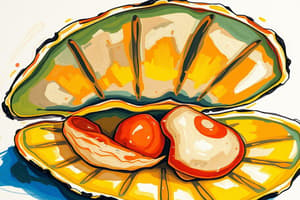Podcast
Questions and Answers
What are Incurrent and Excurrent Siphons?
What are Incurrent and Excurrent Siphons?
Extendable, fleshy tubes that transport water into and out of the body.
What is the primary function of Gills in bivalves?
What is the primary function of Gills in bivalves?
Used primarily for respiration and filter-feeding; female freshwater mussels brood eggs in special gill pouches.
What is the role of the Mantle?
What is the role of the Mantle?
Thin membrane that secretes the shell.
What does the Shell do for bivalves?
What does the Shell do for bivalves?
What is the Foot in bivalves?
What is the Foot in bivalves?
What is housed within the Visceral Mass?
What is housed within the Visceral Mass?
What are Adductor Muscles?
What are Adductor Muscles?
What is the function of Labial Palps?
What is the function of Labial Palps?
What is the role of the Mouth in bivalves?
What is the role of the Mouth in bivalves?
What does the Esophagus do?
What does the Esophagus do?
What is the function of the Stomach in bivalves?
What is the function of the Stomach in bivalves?
What is the Digestive Gland responsible for?
What is the Digestive Gland responsible for?
What occurs in the Intestine?
What occurs in the Intestine?
What is the function of the Anus?
What is the function of the Anus?
What is produced by the Gonad?
What is produced by the Gonad?
What does the Heart do in bivalves?
What does the Heart do in bivalves?
What is the role of the Kidney (nephridium)?
What is the role of the Kidney (nephridium)?
Flashcards are hidden until you start studying
Study Notes
Bivalvia (Clams and Mussels) Key Functions
-
Incurrent and Excurrent Siphons:
- Extendable tubes for water intake and expulsion, essential for circulation.
-
Gills:
- Serve dual function of respiration and filter-feeding; in freshwater mussels, females use gill pouches for brooding eggs.
-
Mantle:
- A thin membrane responsible for shell secretion, playing a critical role in shell development and repair.
-
Shell:
- Hard exterior composed of calcium carbonate and protein, crucial for protecting internal organs from predators and environmental damage.
-
Foot:
- Muscular structure near the visceral mass, facilitating burrowing and locomotion, aiding in habitat placement.
-
Visceral Mass:
- A central pouch containing major internal organs, vital for the overall function of the bivalve.
-
Adductor Muscles:
- Large muscles at both ends of the shell responsible for closure, ensuring tight shell closure against threats.
-
Labial Palps:
- Fleshy skin folds near the mouth that help collect food from gills, directing it towards the mouth for consumption.
-
Mouth:
- The entry point for food ingestion, initiating the digestive process.
-
Esophagus:
- A short tube connecting mouth to stomach, facilitating movement of food.
-
Stomach:
- Small chamber within the visceral mass that holds food, ready for digestion.
-
Digestive Gland:
- Greenish tissue aiding digestion by secreting enzymes into the stomach and intestine to break down food.
-
Intestine:
- Coiled structure where nutrient absorption takes place, crucial for energy intake.
-
Anus:
- Exit point for the elimination of indigestible waste, ensuring waste management.
-
Gonad:
- Organ responsible for gamete production, crucial for reproductive processes.
-
Heart:
- Muscular organ in the circulatory system that pumps blood from gills to tissues, supporting metabolic functions.
-
Kidney (Nephridium):
- Excretory organ that filters nitrogenous wastes from hemolymph and expels them, maintaining internal homeostasis.
Studying That Suits You
Use AI to generate personalized quizzes and flashcards to suit your learning preferences.




